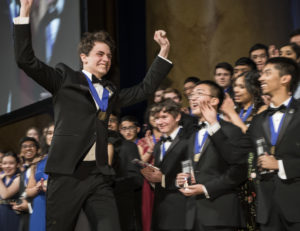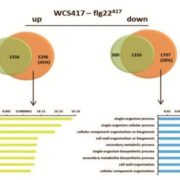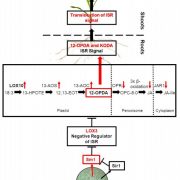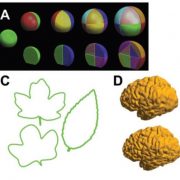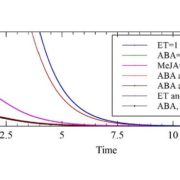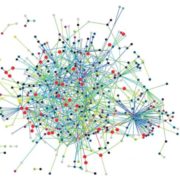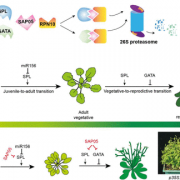Interview with Benjamin Firester, winner of the Regeneron Science Talent Search, 2018
From Facebook to disease control, starting in New York via the UK to the Volcani centre in Israel and back again, my interview with Benjy Firester, winner of the Regeneron Science Talent Search 2018, felt like a whistlestop global tour.
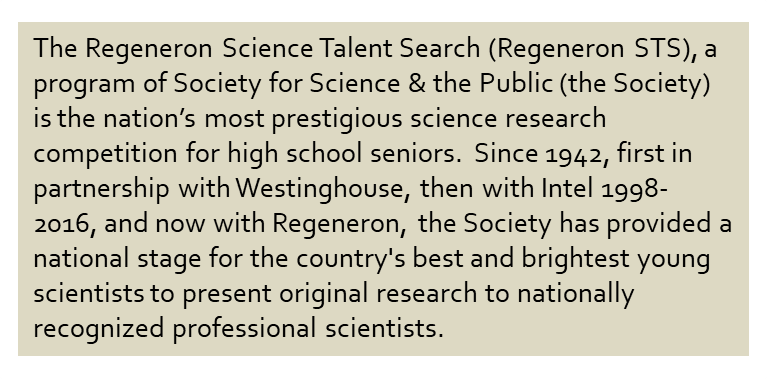 This bright senior student at Hunter College High School in New York began his research journey in the summer after 9th grade. While spending his summers with family in Israel, Benjy approached several labs for opportunities to gain research experience and Dr Lior Blank of the Volcani Center agreed to take him on. It was there that Benjy realised his interest in computer science – in particular graph theory (a type of modelling)- could be applied to predicting the spread of potato late blight – the cause of the Irish Potato famine and still a significant problem globally.
This bright senior student at Hunter College High School in New York began his research journey in the summer after 9th grade. While spending his summers with family in Israel, Benjy approached several labs for opportunities to gain research experience and Dr Lior Blank of the Volcani Center agreed to take him on. It was there that Benjy realised his interest in computer science – in particular graph theory (a type of modelling)- could be applied to predicting the spread of potato late blight – the cause of the Irish Potato famine and still a significant problem globally.
“So what is graph theory?” I asked Benjy.
“Graph theory is I guess a part of mathematics but really tied to computer science. What I mean by graph is actually just a bunch of objects that are connected. The most common example is Facebook. Facebook stores all of everything as a graph. Every person is a node and every friendship is a connection and this kind of data structure is incredibly important in computer science. The study of graph theory is how these connections work and how we can analyse this structure to be really helpful in applications to other things like this. In disease modeling for example the graph in this case is actually the nodes are infected fields and the connections are the infection. One node infects another.”
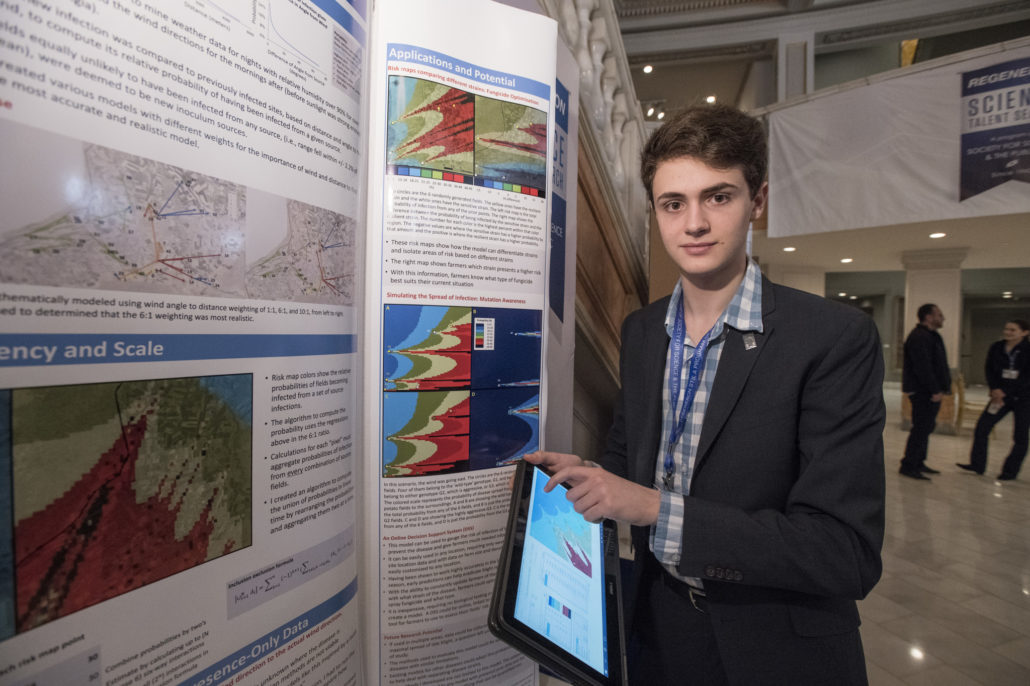 As Benjy finished explaining this one of my favourite board games – Pandemic – sprung to mind. Similar to an outbreak event in Pandemic where neighboring nodes are infected, Benjy’s model predicts the spread of late blight from place to place but unlike the random flip of a card the model takes into account wind conditions to predict the likelihood of that spread.
As Benjy finished explaining this one of my favourite board games – Pandemic – sprung to mind. Similar to an outbreak event in Pandemic where neighboring nodes are infected, Benjy’s model predicts the spread of late blight from place to place but unlike the random flip of a card the model takes into account wind conditions to predict the likelihood of that spread.
“My models gives farmers this necessary information that tells them how and when they are going to be infected and with that they can protect their own fields and on a larger scale prevent epidemics”.
As we chat and get past the practiced spiel, Benjy’s hands become more animated and the sparkle in his eye belies the passion he has for computer science and how useful it can be for modelling real world applications. He describes that one of the challenges he faced was validating his model because of the limited data.
“Even if you say its working and it’s working on like 3 or 4 locations, that doesn’t show it very well. The other thing is late blight is “presence only” data. Meaning you know where the disease is because you can see it but you can never for certain rule out locations.”
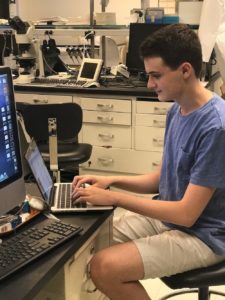 To overcome this Benjy invented a new validation method.
To overcome this Benjy invented a new validation method.
“It works by reversing the inputs and the outputs of the model. So as opposed to taking in the wind direction it takes into account the currently infected fields and the fields that were about to be infected and it predicts the wind direction. The reason this is much better than other types of validation methods is because predicting the wind direction is really hard. If you consider all 360 degrees, the chance of you getting it right is 1/360 so if you get it right lots of times that shows really high statistical significance and it also gets around the fact that it’s only presence only data. So it solved both these problems. Developing the model took a full summer and just doing that one piece took another full summer so that was the biggest challenge.”
Benjy jokes that he’s working in theoretical plant science because he wasn’t working in the field and explains “I think it’s a really powerful tool that we have now in this time and I think it’s not only going to be really helpful in disease modelling but just about everything.”
“Specifically for late blight, I think modelling is a really good approach because late blight develops a disease set or a population that is really diverse and very large, it can reproduce very quickly and mutate very quickly meaning that if you were to design better fungicides or resistant potatoes it’s not only possibly but probably likely that at some point the disease will mutate to get past that. Versus if you are very good at modelling disease you can snuff it out from the beginning so even if it mutates you can contain it and get rid of it more like a vaccine approach to get rid of the disease rather than just trying to cure every potato patch.”
It’s hard to disagree with Benjy’s rational and enthusiastic explanations.
His exciting work is now published in Plant Pathology (link) and led to him winning the Regeneron Science Talent Search 2018.
When I asked Benjy about how it felt to win, a smile lights up his face: “It was unreal, I was so in shock! It was amazing!” “It was a total surprise!”
In advising students interested in entering this competition next year he explains,
“The competition has an incredibly large application which is a really awesome thing. You really get to show every part of yourself as a scientist, not just the research that you’ve done, but how you think and how you see the world. So biggest advice, start early because it takes a long time to finish and don’t be intimidated by the large application.”
This is great advice for anyone writing any kind of application and it’s refreshing to see this lesson learnt by someone so early in their career!
Along with his enthusiasm I was also struck by the scientific maturity gained by this teenager.
“Throughout my research there was a bunch of parts where I really felt stuck. I think the biggest problem was getting to it in my head sometimes where I had preconceived notions on how I thought the data would work out and often times on the most part it didn’t. And this was a good thing. As soon as I let go of these ideas of how I thought it would work out and I really just looked at what the data said, what it meant, and figure out what to do from there the model just kind of modelled itself really.”
His excitement for computer science and the many ways it can be applied to real-world problems is infectious and an excellent example for us all to learn from in terms of both interdisciplinary research and the value of encouraging school students – both for the research community and the students. Benjy says the most valuable thing from this process was …
“Just realising that research is very accessible. It always seems for middle school and high school students something that’s so far in the future. Like you go to college, you go to grad school and then you’re finally getting to do research. But it’s really something that people can approach even if they’re not doing fully independent projects they can always help and work out, share ideas and things. Being able to do research and having some independence on this showed me that you can start really early and that’s really important because it got me so interested and motivated to learn more math and learn more computer science and is going to propel me to do more through my early college career which I think is going to be really exciting. “
Hearing him speak about this experience I find myself inspired to continue expanding the opportunities offered to local school students to help them to also see this accessibility of science.
So what’s next for this theoretical plant scientist?
“I’m really not sure. Still not sure where I’m going to college even. But the only thing I know is that I want to continue doing a lot of studying in math and computer science and broaden my education so that I can really find what I want to do in life.”
Can’t argue with that! I’m sure the future will be bright not only for this exceptional teen but also as a result of the sparks of inspiration created by interacting with enthusiastic scientists just like Benjy.
Listen to Amanda’s interview with Benjy:
